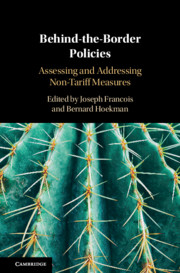Book contents
- Behind-the-Border Policies
- Behind-the-Border Policies
- Copyright page
- Contents
- Figures
- Tables
- Boxes
- Contributors
- 1 Moving beyond the Border
- Part I Concepts and Measurement
- Part II Assessing and Benchmarking Policy
- Part III Dealing with Non-tariff Measures: Legal and Institutional Contexts
- 8 Nontariff Measures Reforms
- 9 Good Regulatory Practices and International Trade
- 10 Rules of Origin as Non-tariff Measures
- 11 Behind-the-Border Measures and the New Generation of Trade Agreements
- 12 Nontariff Responses to China’s Development Strategy
- 13 A Time for Action
- References
- Index
9 - Good Regulatory Practices and International Trade
from Part III - Dealing with Non-tariff Measures: Legal and Institutional Contexts
Published online by Cambridge University Press: 25 October 2019
- Behind-the-Border Policies
- Behind-the-Border Policies
- Copyright page
- Contents
- Figures
- Tables
- Boxes
- Contributors
- 1 Moving beyond the Border
- Part I Concepts and Measurement
- Part II Assessing and Benchmarking Policy
- Part III Dealing with Non-tariff Measures: Legal and Institutional Contexts
- 8 Nontariff Measures Reforms
- 9 Good Regulatory Practices and International Trade
- 10 Rules of Origin as Non-tariff Measures
- 11 Behind-the-Border Measures and the New Generation of Trade Agreements
- 12 Nontariff Responses to China’s Development Strategy
- 13 A Time for Action
- References
- Index
Summary
Regulatory divergences are perceived as the most important trade barriers today (Hoekman, 2015; Hoekman and Mavroidis, 2015a). Over the last decades, countries have significantly lowered classic trade barriers such as tariffs and quotas. In many sectors and trade relationships, diverging regulatory requirements across countries are the main source of trade costs. Diverging regulatory requirements require businesses to get informed about regulatory requirements in other markets, to accordingly specify products and services and ultimately to proof regulatory compliance to local authorities (OECD, 2015a). These information, specification and compliance costs are often sizeable and avoidable. Regulatory divergences in many cases do not reflect diverging public policy objectives. They result from a lack of awareness and information among regulators for the international regulatory environment.
- Type
- Chapter
- Information
- Behind-the-Border PoliciesAssessing and Addressing Non-Tariff Measures, pp. 193 - 208Publisher: Cambridge University PressPrint publication year: 2019



